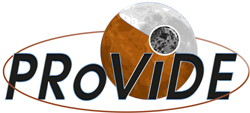Similar to what is shown later for Orbiter data of different resolution (see Figure 12), the same procedure can be continued down to microscopic level. MER (Mars Exploration Rover) data already provides quite mature means of spatial data description documented in the PDS (Planetary Data System) labels attached to the EDR (experiment data records). To give an example, Figure 9 shows the result of fusion between NavCam (Navigation Camera) stereo and PanCam (Panoramic Camera) stereo reconstruction, and a Microscope image overlaid on the NavCam (Navigation Camera) structure and texture. Such combinations are possible without major effort due to the excellent local image orientation quality provided by the PDS (Planetary Data System). PRoViDE (Planetary Robotics Vision Data Exploitation) systematically search the MER (Mars Exploration Rover) EDRs (experiment data records) for such opportunities and produce 3D fusion results similar (or expectedly in higher quality) than those presented here by a prototype processing chain. As implication of that experiment, minor manual alignment effort in the range of 2-5 minutes is expected to precisely overly the MI 2D or 3D data onto the lower resolution products.

Figure 9: Fusion of three levels of scaling using MER (Mars Exploration Rover) image data. Left: Visual Fulcra from image orientations of NavCam (Navigation Camera) and PanCam (Panoramic Camera) Stereo pairs, and Microscope. Right: Fusion between PanCam DEM (Panoramic Camera Digital Elevation Model), NavCam DEM (Panoramic Navigation Digital Elevation Model) and Microscope image texturing the PanCam 3D result. Processing of NavCam and PanCam took place using unmodified PDS (Planetary Data System) CAHV image orientation, the Microscope had to be virtually (manually) shifted by 20 mm towards the Rover, and 1mm to the left, to fit onto the PanCam 3D and texture (Pointing remained unmodified). The vrml data set allows interactive 3D zooming into the APXS (Alpha Particle X-ray Spectrometer) drill hole. Source: Courtesy NASA (National Aeronautics and Space Administration)-JPL[1]. Processing: PRoVisG (Planetary Robotics Vision Ground Processing)



